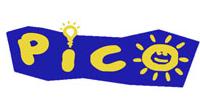Advanced Pico Beena
 |
|
 |
|
| Also known as | Kids Computer Pico |
|---|---|
| Manufacturer | Sega |
| Type | Video game console |
| Generation | Fourth generation era |
| Release date | |
| Introductory price |
JP¥13,440 US$139 CN¥690 US$49.95 (Majesco) |
| Discontinued | |
| Units sold | |
| Media | "Storyware" (Cartridge) |
| Successor | Advanced Pico Beena |
 |
|
| Manufacturer | Sega |
|---|---|
| Type | Video game console |
| Generation | Sixth generation era |
| Retail availability |
|
| Media | Storyware |
| Predecessor | Sega Pico |
The Sega Pico, also known as Kids Computer Pico (キッズコンピューター・ピコ Kizzu Konpyūtā Piko), is an educational video game console by Sega. Marketed as "edutainment", the main focus of the Pico was educational video games for children between 3 and 7 years old. The Pico was released in June 1993 in Japan and November 1994 in North America and Europe, later reaching China. It was succeeded by the Advanced Pico Beena, which was released in Japan in 2005. Though the Pico was sold continuously in Japan through the release of the Beena, in North America and Europe the Pico was less successful and was discontinued in early 1998, later being rereleased by Majesco Entertainment. Releases for the Pico were focused on education for children and included titles supported by licensed franchised animated characters, including Disney and Sega's own Sonic the Hedgehog series. Overall, Sega claims sales of 3.4 million Pico consoles and 11.2 million game cartridges, and over 350,000 Beena consoles and 800,000 cartridges.
Powered by the same hardware used in the Sega Genesis, the physical shape of the Pico was designed to appear similar to a laptop. Included in the Pico are a stylus called the "Magic Pen" and a pad to draw on. Controlling the games for the system is accomplished either by using the Magic Pen like a mouse or by pressing the directional buttons on the console. The Pico does not include its own screen or RF output, and instead must be connected to a monitor through a VCR in order to be played. Touching the pen to the pad would either allow drawing or animate a character on the screen.
Cartridges for the system were referred to as "Storyware", and take the form of picture books with a cartridge slot on the bottom. The Pico changes the television display and the set of tasks for the player to accomplish each time a page is turned. Sound, including voices and music, also accompanied every page. Games for the Pico focused on education, including on subjects such as music, counting, spelling, reading, matching, and coloring. Titles included licensed animated characters from various franchises, such as Disney's The Lion King: Adventures at Pride Rock and A Year at Pooh Corner. Sega also released titles including their mascot, Sonic the Hedgehog, including Sonic Gameworld and Tails and the Music Maker.
...
Wikipedia
